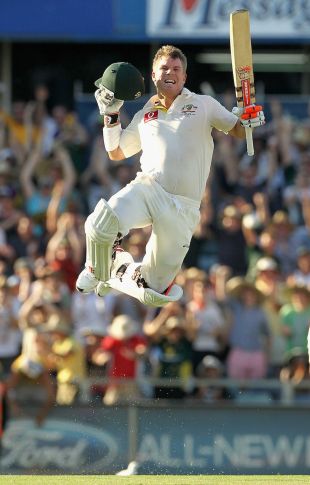Australia v India in Australia, 2011-12
At Perth, January 13-15, 2012. Australia won by an innings and 37 runs. Toss: Australia. Test debut: R. Vinay Kumar.

|
|||
|
Related Links
Tour and tournament reports : Australia v India in Australia, 2011-12
Matches:
Australia v India at W.A.C.A
Series/Tournaments:
Border-Gavaskar Trophy
|
|||
As they had done four years earlier, India came to Perth 2-0 down. But this time it was all rather more cordial: Australia were not feeling let down by criticism from their own fans; India could not complain about being victimised. In 2007-08, India converted what they believed to be the wrong perpetrated against them in the previous game at Sydney into a force that bound them together, and produced one of their finest Test moments. In 2011-12, Australia were not distracted - merely motivated by the idea of winning a Test series.
The teams were greeted by bright sunshine, hot summer days and a bouncy pitch. India would not have minded the first two (though it was warm even by subcontinental standards), but the third threatened to lay low a side already reeling on the ropes. Australia picked four quicks, drafting in Harris and left-armer Starc for off-spinner Nathan Lyon and the injured James Pattinson - and, for once, "quicks" was not merely another word for new-ball bowlers. Hilfenhaus had added 5-6mph to his arsenal after struggling to bend one past the outside edge a year earlier in the Ashes; Siddle bowled fuller and quicker and - like Harris - snaked the ball wickedly; Starc, neither Bruce Reid nor Mitchell Johnson, provided welcome variety. Each of them operated in excess of 87mph, but also found excellent lengths.
As if in expectation of this, Clarke inserted India, who also went for a four-man seam attack, handing a Test debut to Vinay Kumar at the expense of off-spinner Ashwin, whose absence further hindered India's over-rate. The drama that followed vindicated Clarke's decision. With doubts in their mind and occasional inadequacy in their techniques, the batsmen floundered to 161 after brief resistance from Laxman and Kohli. And when Sharma was last out, Australia still had the best part of a session to bat. Few could have imagined what was to follow.
In the months leading up to this game, Warner had scored back-to-back centuries in the Champions League and added another in the rebranded Big Bash. But we were told 20- over cricket was the root of most evils. Test matches, they said, demanded best behaviour: shed the tattoos, Bermudas and beer for a suit and a briefcase. As Warner bounded into the ring, convinced that each ball needed a jab, a hook or an upper-cut, the difference blurred. The new ball was thumped over long-on - not once, not twice, but almost as if a habit; cuts and pulls flew like popcorn in a microwave. On the radio, Kerry O'Keeffe wondered if a fast bowler might ever ask: "Can I have my long-on a bit straighter, please?"
Twenty overs into Australia's reply, Warner had another hundred, from 69 balls. He had reached Test cricket's joint-fourth-fastest century in terms of balls faced - and the quickest by an opener - with his third six, a huge blow over long-on off Kumar; at the other end, Cowan had 38. Admittedly, the bounce was true - Perth now had four of Test cricket's seven fastest hundreds - and the speed of India's bowling amiable, in spite of the admirable Yadav. But it requires a special player to see a scoring opportunity rather than a potential dismissal in the big hit and the crisp cut. Some of the shots must have been pre- determined - which is not to belittle Warner, only to admire his conviction.
Many strokes stood out during the course of his 180 from 159 deliveries: a short-arm pick-up for six high over wide long-on in Vinay Kumar's first over; and another, off Sharma, which was fetched from outside off and deposited beyond a reasonably distant straight boundary. But none took the breath away more than a lofted cover-drive for six off Zaheer Khan after lunch on the second day. Appropriately enough, it was played into the John Inverarity Stand: the former headmaster, now chief selector, may have only grudgingly accepted the grammar, but he would have appreciated the audacity.
Almost unnoticed, Cowan helped take the opening stand to 214 before he was bowled by Yadav. Occasionally he would cut and pull and, in showing judgment in the leave, fulfilled the job description of an opener as his partner was redefining it. Even so, Cowan's 74 in three hours was no dirge. He deserved the best view in the house.
Warner, who in all hit 20 fours and five sixes in four hours 18 minutes of mayhem, eventually died by the sword, caught at long-on off Sharma, and Australia's collapse of all ten for 155 merely highlighted the importance of his and Cowan's contributions. Other than them, there was little to choose between the two sets of batsmen.
India trailed by 208, but only Dravid and Kohli, whose retention had sparked some debate, looked the part. The game was all over shortly after lunch on the third day, as Hilfenhaus continued his revival with a Test-best match haul of eight for 97. India's last six had tumbled for 36 - they had managed only 30 in the first innings - and the last four for none at all.
As the sun set that evening beyond the Swan River, and Australia celebrated a 3-0 lead and the regaining of the Border-Gavaskar Trophy, it was tempting to imagine the same fate awaited some of the great names in India's batting line-up.
Man of the Match: D. A. Warner.

